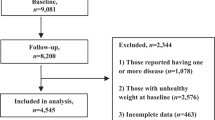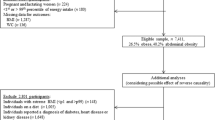Abstract
Background/Objectives:
To observe fruit and vegetable consumption as it relates to body mass index (BMI) and other variables, by analyzing the health surveys of two countries—the United States and France—with traditionally distinct diets, and identifying factors that may explain the differences.
Subjects/Methods:
Two nationally representative surveys that assess food intake via 24-h diet recalls. Respondents include 2126 women and 1911 men from the US National Health and Nutrition Examination Survey, and 1572 women and 1141 men from the French Nutrition Barometer Survey. Standard linear regression models and t-tests of both simple and predictive marginal means were run employing the software package SUDAAN.
Results:
Americans appear to consume fruits and vegetables less often than their French counterparts (1.04 vs 1.33 times per day fruits; 1.98 vs 2.29 times per day vegetables). American men consume fruits and vegetables least often (0.98 times per day fruits; 1.88 times per day vegetables) than do American women or French men (1.10 vs 1.25 times per day fruits; 2.07 vs 2.18 times per day vegetables). French women consume fruits and vegetables most often (1.41 times per day fruits; 2.41 times per day vegetables). The French have lower mean BMI than Americans (23.34 vs 28.22 women; 25.20 vs 28.02 men). Regression analyses showed that age, BMI and educational attainment are strongly associated with frequency of consumption.
Conclusions:
These results support our hypothesis that the French tend to eat fruits and vegetables more often than Americans. This study proves to be an important first step in determining some of the influential factors that may affect various populations' consumption of fruits and vegetables.
This is a preview of subscription content, access via your institution
Access options
Subscribe to this journal
Receive 12 print issues and online access
$259.00 per year
only $21.58 per issue
Buy this article
- Purchase on Springer Link
- Instant access to full article PDF
Prices may be subject to local taxes which are calculated during checkout
Similar content being viewed by others
References
Adler NE, Newman K (2002). Socioeconomic disparities in health: pathways and policies. Health Aff 21, 60–76.
Baranowski T, Davis M, Resnicow K, Baranowski J, Doyle C, Lin LS et al. (2000). Gimme 5 fruit, juice, and vegetables for fun and health: outcome evaluation. Health Educ Behav 27, 96–111.
Baudier F, Carel D, Delamaire C, Gautier A, Guilbert P, Le Bihan G et al. (2002). Baromètre Santé Nutrition. Paris: Institut National de Prévention et d'Éducation pour la Santé.
Brogan DJ, Denniston MM, Liff JM, Flagg EW, Coates RJ, Brinton LA (2001). Comparison of telephone sampling and area sampling: response rates and within-household coverage. Am J Epidemiol 153, 1119–1127.
Cordain L, Eaton SB, Sebastian A, Mann N, Lindeberg S, Watkins BA et al. (2005). Origins and evolution of the Western diet: health implications for the 21st century. Am J Clin Nutr 81, 341–354.
Cutler DM, Glaeser EL, Shapiro JM (2003). Why have Americans become more obese? J Econ Perspect 17, 93–118.
Drewnowski A, Henderson SA, Shore A, Fischler C, Preziosi P, Hercberg S (1996). Diet quality and dietary diversity in France—implications for the French paradox. J Am Diet Assoc 96, 663–669.
Field AE, Aneja P, Rosner B (2007). The validity of self-reported weight change among adolescents and young adults. Obesity 15, 2357–2364.
Ghadirian P, Shatenstein B, Lambert J, Thouez JP, PetitClerc C, Parent ME et al. (1995). Food habits of French Canadians in Montreal, Quebec. J Am Coll Nutr 14, 37–45.
Gregory-Mercado KY, Staten LK, Ranger-Moore J, Thomson CA, Will JC, Ford ES et al. (2006). Fruit and vegetable consumption of older Mexican-American women is associated with their acculturation level. Ethn Dis 16, 89–95.
Haines PS, Hama MY, Guilkey DK, Popkin BM (2003). Weekend eating in the United States is linked with greater energy, fat, and alcohol intake. Obes Res 11, 945–949.
Holdsworth M, Gerber M, Haslam C, Scali J, Beardsworth A, Avallone MH et al. (2000). A comparison of dietary behaviour in Central England and a French Mediterranean region. Eur J Clin Nutr 54, 530–539.
Institut National de la Santé et de la Recherche Médicale (2006). Obésité des Jeunes. Institut National de la Santé et de la Recherche Médicale: Paris, France.
Irala-Estevez JD, Groth M, Johansson L, Oltersdorf U, Prattala R, Martinez-Gonzalez MA (2000). A systematic review of socio-economic differences in food habits in Europe: consumption of fruit and vegetables. Eur J Clin Nutr 54, 706–714.
Korn E, Graubard B (1999). Analysis of Health Surveys. New York: John Wiley.
Kuczmarski MF, Kuczmarski RJ, Najjar M (2001). Effects of age on validity of self-reported height, weight, and body mass index: findings from the Third National health and Nutrition Examination Survey, 1988–1994. J Am Diet Assoc 10, 28–34.
Le Programme National Nutrition Santé (2007). Campagnes de Communications. Institut National de Prévention et d'Éducation pour la Santé: Paris, France.
McAdams MA, Van Dam RM, Hu FB 2007)). Comparison of self-reported and measured BMI as correlates of disease markers in US adults. Obesity 15, 188–196.
Moreau C, Bajos N, Bouyer J, The Cocon Group (2004). Access to health care for induced abortions. Eur J Public Health 14, 369–374.
National Center for Chronic Disease Prevention and Health Promotion (2007). Overweight and Obesity. Centers for Disease Control and Prevention: Atlanta, GA, USA.
National Center for Health Statistics (2002). National Health And Nutrition Examination Survey 2001–2002. Centers for Disease Control and Prevention: Atlanta, GA, USA.
Office of Disease Prevention and Health Promotion (2005). Dietary Guidelines for Americans 2005. United States Department of Agriculture: Washington DC, USA.
Perrin AE, Dallongeville J, Ducimetiere P, Ruidavets JB, Schlienger JL, Arveiler D et al. (2005). Interactions between traditional regional determinants and socio-economic status on dietary patterns in a sample of French men. Br J Nutr 93, 109–114.
Perrin AE, Simon C, Hedelin G, Arveiler D, Schaffer P, Schlienger JL (2002). Ten-year trends of dietary intake in a middle-aged French population: relationship with educational level. Eur J Clin Nutr 56, 393–401.
Rozin P (2005). The meaning of food in our lives: a cross-cultural perspective on eating and well-being. J Nutr Educ Behav 37, S107–S112.
Rozin P, Kabnick K, Pete E, Fischler C, Shields C (2003). The ecology of eating: smaller portion sizes in France than in the United States help explain the French paradox. Psychol Sci 14, 450–454.
Serdula MK, Gillespie C, Kettel-Khan L, Farris R, Seymour J, Denny C (2004). Trends in fruit and vegetable consumption among adults in the United States: behavioral risk factor surveillance system, 1994–2000. Am J Public Health 94, 1014–1018.
Stables GJ, Subar AF, Patterson BH, Dodd K, Heimendinger J, Van Duyn MA et al. (2002). Changes in vegetable and fruit consumption and awareness among US adults: results of the 1991 and 1997 5 A Day for Better Health Program surveys. J Am Diet Assoc 102, 809–817.
Vecchia CL (2004). Mediterranean diet and cancer. Public Health Nutr 7, 965–968.
Volatier JL, Verger P (1999). Recent national French food and nutrient intake data. Br J Nutr 81 (Suppl 2), S57–S59.
World Cancer Research Fund (1997). Food, Nutrition and the Prevention of Cancer: A Global Perspective. World Cancer Research Fund: London, UK.
Acknowledgements
We acknowledge the invaluable assistance of l'Institut National de Prévention et d'Éducation pour la Santé (INPES). We also express gratitude to Andrea C. Dunlavy for critical review and scientific editing and to Josseline de Saint Just for translational aid. None of the authors had any personal, professional or financial links that compromised the scientific veracity of this study.
Author information
Authors and Affiliations
Corresponding author
Additional information
Contributors: SLT was responsible for initiating the study, coordinating the analysis and writing the manuscript. TA-C was involved in the project design and assisted in the manuscript preparation. KWD was responsible for the statistical analyses, interpretation of results and manuscript editing. LN offered support and supervised the project. All authors provided input during the preparation of the manuscript and approved the final version submitted for publication.
Rights and permissions
About this article
Cite this article
Tamers, S., Agurs-Collins, T., Dodd, K. et al. US and France adult fruit and vegetable consumption patterns: an international comparison. Eur J Clin Nutr 63, 11–17 (2009). https://doi.org/10.1038/ejcn.2008.2
Received:
Revised:
Accepted:
Published:
Issue Date:
DOI: https://doi.org/10.1038/ejcn.2008.2
Keywords
This article is cited by
-
Weight-Related Dietary Behaviors in Young Adults
Current Obesity Reports (2016)
-
Neighbourhood socioeconomic disadvantage and fruit and vegetable consumption: a seven countries comparison
International Journal of Behavioral Nutrition and Physical Activity (2015)
-
Does food store access modify associations between intrapersonal factors and fruit and vegetable consumption?
European Journal of Clinical Nutrition (2015)
-
Associations between fruit and vegetable intake, leisure-time physical activity, sitting time and self-rated health among older adults: cross-sectional data from the WELL study
BMC Public Health (2012)
-
Consumption of fruit and vegetables among elderly people: a cross sectional study from Iran
Nutrition Journal (2010)



